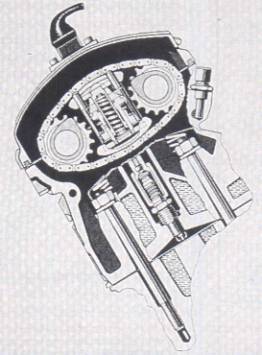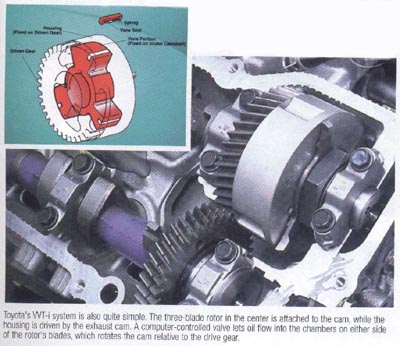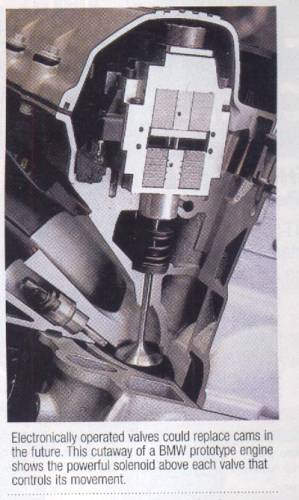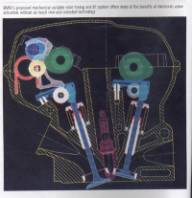
The differential between
VTEC system for Honda Jazz and other carís series.
Variable
Timing
Systems that change only
timing are far simpler then either the VTEC or VVL systems. It is generally well
known that adjusting cam timing with adjustable cam sprockets can yield
significant gains at certain points in the powerband, but always at the
expense of power somewhere else. If you are designing engines that have to meet
LEV (Low Emissions Vehicle), ULEV (Ultra-Low Emissions Vehicle), or even SULEV
(Super Ultra-Low Emissions Vehicle) standards, you have other concerns that can
be affected by cam timing as well. Emissions, drivability, cold startability -
the effects of cam timing are far reaching. A sophisticated cam sprocketthat can
advance and retard intake and/or exhaust cams on the fly eliminates most of the
compromises inherent in cam timing.
The number of engines equipped with some sort of adjust-on-the-fly cam sprocket
is huge, and growing rapidly. nissan has used a system called VTC (Valve Timing
Control) on the Infiniti Q45 and the turbocharged Nissan Silvia, among others.
Toyota has begun using VVT-i (Variable Valve Timing with intelligence)
extensively on their high end US models (most of which are under the Lexus
badge), but as they refine the system and reduce the costs associated with it,
VVT-i is bound to find it's way down to the four cylinder models very soon. Ford
has already brought their variable valve timing down to the 2.0 liter Zetec
engine, but unfortunately only on the exhaust cam where it improves emissions
but does almost nothing for horsepower.
The actual mechanismsused to advance and retard the cams vary enormously, but
two systems in particular deserve a closer look for how incredibally simple they
are.

Porsche's VarioCam, used first on the 968 and know used without the fanfare on
all (both) of their engines is as simple as it gets. With VarioCam, the exhaust
cam is driven by the crank, and the intake cam is driven, via a short chain, by
the exhaust cam. In order to advance and retard the intake cam, the chain
tensioner on that short chain simply shifts up and down, moving the extra length
in the chain from the tight side to the slack side. When the tight side has no
extra chain (ie. the chain is straight), the intake cam is fully advanced, as
more chain is shifted to the tight side, the cam is retarded.

Toyota's newest version of VVT-i is also quite simple, though it may look
otherwise on initial inspection. Again, the exhaust cam is driven from the
crank, while the intake cam is driven off the exhaust cam. This time, the drive
is via gears, and a mysterious cylinder behind the drive gear on intake cam
controls cam timing. Inside this mysterious cylinder is a simple three fluted
rotor that actually drives the cam. By pumping oil into the chambers on either
side of the three flutes, the hydraulic pressure can force the cam to advance or
retard. This replaces the previous VVT-i system which was basically an
incomprehensible little box of gears, springs and splines.
The
VVT-i system can change the intake cam timing over a 60 degree range, changing
valve overlap from absolutely zero (for smooth idle, easy starting and better
cold start performance), to severely overlapped for a natural EGR effect at
medium load (eliminating the need for an Exhaust Gas Recirculation valve), to
whatever is ideal for maximum power at any point on the powerband.
The
Future
If all this exotic variable valve timing technology is commonplace now, what does the future hold? Currently we are limited to either adjusting overlap by moving a standard camshaft, or switching between two fixed cam profiles. There is no reason (other then cost) why both systems could not be used in parallel on one engine, but the benifits may be limited. The true future of variable valve timing is infinite adjustability of both lift and timing.

The idea of opening and closing the valves with large electrical solenoids has
been bounced around for several years. Many different manufacturers from Cummins
to BMW have proposed such systems, and even made running prototypes. There are a
few problems with electronically operated valves, but let's look at the
advantages first.
Current gasoline engines control part throttle airflow via a throttle plate,
essentially lowering the air pressure in the intake manifold by choking it off
with a partially closed throttle plate. This causes significant pumping losses
as the engine fights to suck air in from the manifold, and ultimately reduces
the efficiency of the engine. If you limit airflow by reducing the time that the
intake valve is open, though, pumping losses could be significantly reduced.
At wide open throttle (or full down pedal in the case of a throttleless engine) the valve timing could be constantly adjusted for maximum power - with no worries about one valve timing profile having to work from idle and redline like they do know.
Now the downside. Eliminating all of the valvetrain reduces the cost and
complexity engine and reduces the internal drag, but not as much as you might
think. Opening and closing the valves takes a certain amount of power, whether
that power comes through a timing belt or a wire, it has to come from somewhere.
In this case, the power would have to come from a huge alternator. This is not
really a problem, but it is an extra cost that isn't initially obvious. More
serious is the question of how to close the valves quickly but still have it
land on the valve seat gently. With a cam, you just shape the lobe so it drops
shut quickly and then slows down just before the seat. With a solenoid operating
the valves, it takes sophisticated electronic controls
Finally, there is the matter of rpm limitations. Ideally, with strong enough
solenoids, the engine would be able to spin even faster then a conventional
engine, but the current solenoids have a hard time working that fast. On the
flip side, though, because the valve opening speed is not engine related, mid
rpm performance could be greatly improved by having the valves slam to full open
much faster than a conventional valvetrain, improving volumetric efficiency and
making more power.
Finally, BMW has actually designed a mechanical system that still uses
conventionalcam lobes, but is still able to vary lift and timing by moving the
fulcrum point of the rocker arm. The system is incrediblydifficult to visualize
(I still don't get it.) but it could offer most of the advantages of
electrically actuated valves without delving

With the current variable timing technologies, the 100 hp per liter hurdle has
been cleared. Honda, in particular, has knocked the hurdle over and stomped it
into the ground. With the technologies on their way, 150 hp per liter is on the
horizon. I, for one, can't wait.